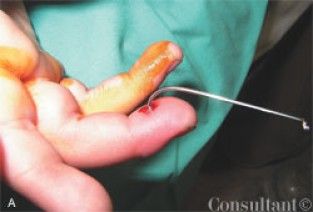Fishhook in Boy's Finger
What's the best way to dislodge a fishhook? What if there is bony involvement?
A 3-year-old boy was at home with his cousin who was preparing for a fishing trip when a fishhook accidentally became lodged in the distal part of the child’s right middle finger. Radiographs confirmed the absence of bony infiltration.

Which statement(s) about removing a fishhook is true?
Related Content